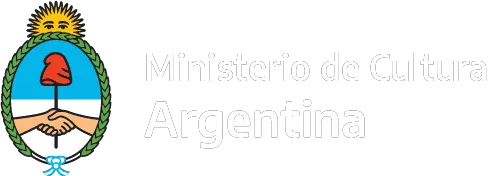Argentina’s foreign trade is the exchange of goods, products and services with other countries or economic regions. Since the implementation of Mercosur in 1995, Argentina’s foreign trade has been mainly with Brazil. The latter being Argentina’s main trading partner, both in terms of export and import, ahead of the US, China and the EU.
Since 2015, new policies have been put in place to stimulate international trade. To do this, withholdings on agricultural exports have been eliminated or reduced. For this reason, Argentina seeks to deepen trade relations with the EU, starting with the signing of the Free Trade Agreement, in addition to stimulating ties with the US, China.
What is Mercosur
Mercosur, the Common Market of the South, is a decision of the States Parties to establish a Common Market. It was formed in 1991 with the Treaty of Asunción for the Constitution of a Common Market of the South, which was to enter into force on December 31, 1994. Subsequently, on January 1, 1995, a free trade zone, with an imperfect customs union, became operational. This took place, among the founding states, Argentina, Brazil, Paraguay and Uruguay.
Mercosur had two priority objectives over time.
On the one hand, establish:
La libre circulación de bienes, servicios y factores productivos entre los países, a través, entre otros, de la eliminación de los derechos aduaneros y restricciones no arancelarias a la circulación de mercaderías y de cualquier otra medida equivalente
On the other hand, determine:
El establecimiento de un arancel externo común y la adopción de una política comercial común con relación a terceros Estados o agrupaciones de Estados y la coordinación de posiciones en foros económicos-comerciales regionales e internacionales
There are two more goals, which have not yet been implemented. Both necessary, to finish forming a Common Market.
You can see the full text in Objetivos del MERCOSUR
To know more about Argentina’s relationship with its continental partners, we suggest:
Read more about Argentina Continental Integration>>
MERCOSUR Evolution
In the 25 years that have passed since its inception, MERCOSUR has only reached its first stage of integration. At this time, it is still an imperfect customs union. It has preferential tariff zones and free trade zones. MERCOSUR will surely have to rethink new goals. Perhaps the Common Market and the Economic Union are no longer achievable objectives.
The result of years of validity of the MERCOSUR highlights the interdependence between the four countries. The main asset of the Block has been its regional market.
On December 15, 1996, the EU and MERCOSUR signed an agreement in Madrid. It was the Interregional Framework Agreement for Cooperation between the European Union and MERCOSUR. Consequently, both regional blocs began negotiations. Furthermore, the negotiations, begun 23 years ago, between the European Union and MERCOSUR are still continuing. The conditions of the Free Trade Agreement are still under discussion. Basically, the big obstacle is agricultural livestock products. These products, which are the most competitive among the MERCOSUR countries, are subject to the protectionist policies of the EU
Currently, the international situation registers a brake in the globalization process. While protectionist policies are being implemented by the US and the EU, Argentina pursues the opening of markets.
NCM and AEC nomenclators
The nomenclature were then defined. The MERCOSUR Common Nomenclature, NCM, is a system that allows the individualization and classification of merchandise traded. That is, between the Member States of MERCOSUR, and between them and the rest of the world. The NCM is based on the Harmonized System of Designation and Codification of Goods. To consult the nomenclators see here.
In this way, each of these identified merchandise is assigned a value, expressed as a percentage, called Tariff. This is the tax that each merchandise will pay when entering Mercosur, by any of its States Parties.
The Common External Tariff (AEC) that was adopted in 1994. Through Decision 22/94 of the Common Market Council (CMC).
Foreign trade since 1995
A new stage in Argentina’s foreign trade begins in 1995. With the imperfect Customs Union, which admits some exceptions, with a special regime. Meanwhile, the Common External Tariff also contemplates some temporary exceptions..
During 1995, the foreign trade deficit obtained the previous year, of -5.8 billion dollars, was reversed. While exports amounted to 17,503 million, imports were 16,432 million. The surplus therefore was 1,071 million.
Between 1998 and 2002, the decline of the neoliberal government of Carlos Menem occurred. Then, you get out of convertibility whereby 1 peso was equal to 1 dollar. Also putting an end to the financial corralito. During this period, exports are higher than 1995, around 25,000 million dollars.
In 2003, with the implementation of new economic policies, the exported volume rises to 31,511 million dollars. In 2008, Argentina’s foreign trade reached 68,658 million dollars. Later it suffers a fall in 2009, the year of elections. In that year, it drops to 56,555 and then reaches 84,295 million dollars in 2011..
External sales, with the exception of 2009, grew until 2011-2013. Then this trend was reversed.
Evolution of foreign trade in Argentina from 2013 to 2020
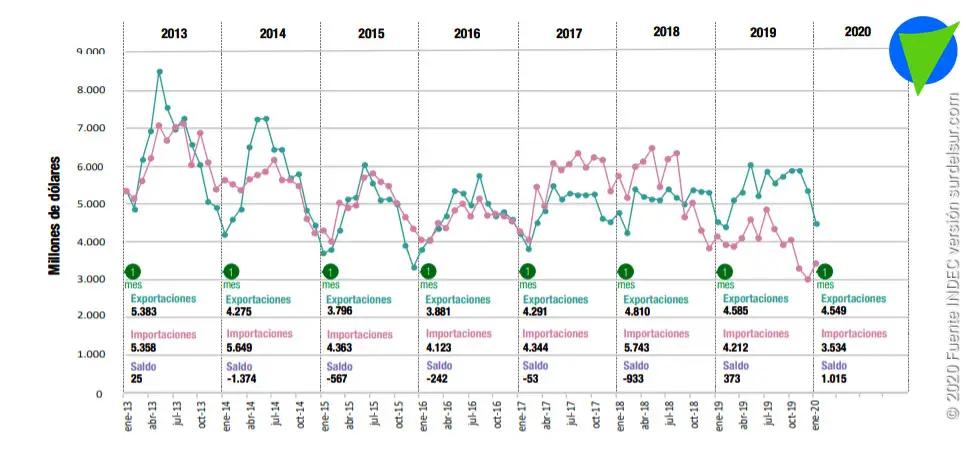
As can be seen in the graph, the downward trend since January 2013 has been greater in imports than in exports. The values shown in figures correspond to January of each year.
Summary of Argentina’s foreign trade 2022
The data that we provide below are based on the reports of INDEC, Dirección Nacional de Estadísticas del Sector Externo. Buenos Aires, febrero de 2022..
According to the terminology used by IRAM, the Argentine trade exchange (ICA) shows the evolution of the Argentine trade balance, which is the relationship between the income in dollars from the products that the country exports to the world and those articles that they buy abroad. The data is presented by imports of large items and imports by economic uses, according to economic zones and selected countries.
Synthesis of the results
In January 2022, exports reached 5,547 million dollars and imports,
FUENTE: INDEC Informes Técnicos / Vol 6 n°3
5,251 million dollars. Trade (exports plus imports) increased 23.3%, in relation to the same month of the previous year, and reached an amount of 10,798 million dollars. The trade balance registered a surplus of 296 million dollars.
Imports and exports 01/2022
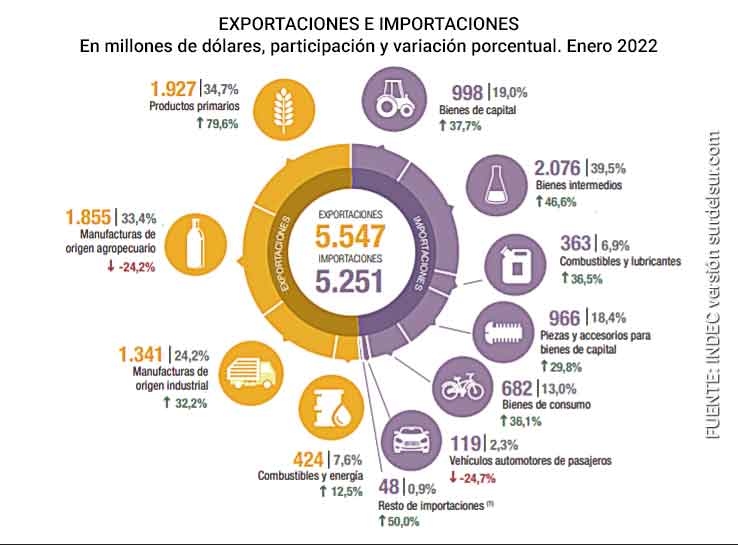
Argentina’s international trade partner countries
The main trading partners of Argentina (taking into account the sum of exports and imports) are in descending order: Brazil, China, the United States, Netherlands, Chile, India, Germany.and Indonesia.

What does Argentina export
Export goods
These are the export goods that represented 91.2% of total exports in 2021, of which 76.9% of total exports are led by soybeans, corn, automotive, oil-petrochemical, bovine meat and leather, wild, gold and silver, fishing, sunflower, and dairy.
Agricultural Origin Manufactures (MOA)
Among the main products that Argentina exports are Agricultural Origin Manufactures (MOA). The countryside and the agro-industry make a great contribution to Argentina’s foreign trade.
Sorted by importance, below are the main items:
- Residues and waste from the food industry
- Fats and oils
- Meats and their preparations
- Vegetable, legume and fruit preparations
- Milling products and their preparations
- Hides and skins
- Dairy products
To expand concepts on the agricultural landscape:
See more Argentina Agriculture
Learn more Argentina Livestock
Industrial Origin Manufactures (MOI)
Exports of Industrial Origin Manufactures (MOI) reached an exported volume of 19,221 million dollars in 2019. Among exports of Manufactures of Industrial Origin (MOI), the following stand out:
- Land transport equipment
- Chemical and related products
- Stones, precious metals and their articles, coins.
- Common metals and their manufactures
- Machines and appliances, electrical equipment
More about Argentina Industrial Activity
Primary products (PP)
The main Primary Products (PP) intended for foreign trade are:
- Cereals
- Oil seeds and oleaginous fruits
- Raw fish and shellfish
- Fresh fruits
- Unprocessed vegetables and legumes
- Metalliferous minerals, slag and ash
Fuels and Energy (CYE)
The fourth and last group is that of Fuels and Energy. They predominate in the group:
- Fuel
- Petroleum gas and other gaseous hydrocarbons
The most exported products from Argentina
Among the products destined for foreign trade, agricultural products and their derivatives have a prominent place.
The following complexes account for 76.5% of total exports:
- Soy
- Corn
- Petroleum-petrochemical
- Wheat
- Automotive
- Bovine meat and leather
- Gold and silver
- Fishing
- Peanut
- Barley
To where Argentina exports
Argentina’s main destination for its exports is MERCOSUR, where approximately 80% of exports to the bloc were destined for Brazil.
The destinations of Argentine exports are: Brazil, China, United States, Chile, India, Netherlands, Germany, Indonesia..
What does Argentina import
Argentina basically imports inputs dedicated to the production of goods and services: motor vehicles and tractors, fuels and mineral oils, nuclear reactors, boilers, machines, apparatus and mechanical devices and their parts, among others.
- Intermediate Goods (BI): Intermediate Goods is basically made up of manufactured Industrial Supplies not specified in other items.
- Capital Goods (BK): The import of Capital Goods is formed in a higher percentage, by Capital Goods excluding transport equipment.
- Parts and Accessories for Capital Goods (PYA): Parts and accessories for capital goods mostly used for the manufacture of vehicles
- Fuels and lubricants (CYL): To satisfy the deficit of internal demand
- Consumer Goods (BC): Consumer Goods are represented by Non-Durable Consumer Items not otherwise specified.
- Passenger motor vehicles (VA)
Where does Argentina import from
In the case of economic zones, the main origin of Argentine imports is MERCOSUR, the European Union and USMCA ex Nafta
For their part, the main countries of origin of imports were Brazil, China, the United States, Germany, and India, which represented 73.1% of total purchases abroad.
Bibliografía
- INDEC Informes Técnicos / Vol 6 n°3, Intercambio Comercial Argentino. Buenos Aires, febrero de 2022
- Bolsa de Cereales y Productos, Bahía Blanca: Los rubros del agro y su impacto en la balanza comercial. Intercambio Comercial Argentino.



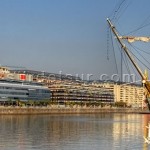


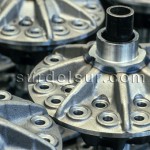
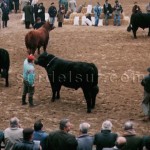
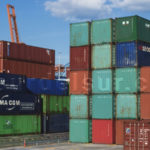
![Agriculture in Argentina: Crops, Productive Areas [2024] 11 Agriculture in Argentina: Crops, Productive areas](https://surdelsur.com/en/wp-content/uploads/sites/3/2015/03/agricultura-en-argentina-panorama-150x150.jpg)



